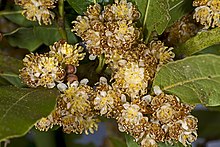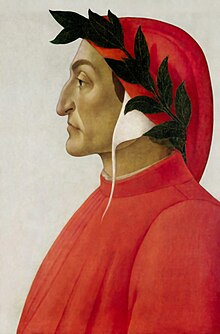Real laurel
| Real laurel | ||||||||||||
|---|---|---|---|---|---|---|---|---|---|---|---|---|

Real laurel ( Laurus nobilis ), illustration |
||||||||||||
| Systematics | ||||||||||||
|
||||||||||||
| Scientific name | ||||||||||||
| Laurus nobilis | ||||||||||||
| L. |
The real laurel ( Laurus nobilis ), also called noble laurel or spice laurel , also called laurel for short , is a species of the laurel genus ( Laurus ) within the laurel family (Lauraceae). It is used as a medicinal and aromatic plant. The name is derived from Middle High German lōrber (for laurel , the fruit of the laurel tree) and Old High German lōr (beri) from synonymous Latin laurus . The (dried) leaves of real laurel used as a spice are also called laurel .
“Laurels” is also used to denote the award of a laurel wreath for an achievement.
description
Vegetative characteristics
The real laurel is an evergreen shrub or tree and can reach heights of up to 10 meters. The leathery leaves , shiny on top, have an aromatic scent. Its edge is slightly wavy.
Generative characteristics
The small green-yellow or whitish flowers are grouped together in dold-like inflorescences . The berries are shiny and blue-black.
The number of chromosomes is 2n = 36, 42, 48, 54, 60, 66 or 72.
Distribution and culture conditions
The real laurel, coming from the Middle East , has spread over the Mediterranean to the Pacific north-western North America .
Since it is only partially hardy , it only survives in the Rhineland , on Lake Constance and climatically similarly mild areas of Germany with winter protection planted outdoors all year round. On Heligoland you can find some large planted specimens that have been thriving successfully without winter protection since the 1980s. In rougher areas it can only be kept as a container plant . As a planted outdoor plant, it also thrives in southern Ireland and withstands the winters there without any problems due to the climatic conditions.
ingredients
The fruit (Fructus Lauri), called laurel, contains essential and fatty oils . If the laurels are pressed and boiled, the result is a mixture called Oleum Lauri ( laurel oil , also laurel oil ). It is colored green by chlorophyll and is an ointment-like mass that melts at 36 ° C. In detail, the fruit contains up to 30% fatty oil and about 1% essential oil ( terpenes , sesquiterpenes , alcohols and ketones ).
The leaf contains 1.3% essential oil (Ol. Lauri folii), therein 45% cineole , 12% terpenes, 3-4% sesquiterpenes, 3% methyleugenol and further α- and β-pinene, phellandrene , linalool , geraniol and terpineol . Substances (G / O).
use
The real bay leaf is used as a spice plant: the aroma of the leaves of the bay tree goes well with soups , stews , meat dishes, but also with fish . The leaves are also used to season pickled cucumbers and herrings , for brawns and to flavor vinegar . Bay leaves are part of the bouquet garni in French cuisine.
Plant species with aromatic leaves exist throughout the flora. Many of them are called laurel, although they hardly show any similar taste to real laurel. These include the Indian laurel ( Cinnamomum tamala ), the West Indian laurel ( Pimenta racemosa ), the Indonesian laurel ( Syzygium polyanthum ), the California laurel ( Umbellularia californica ) and the Mexican laurel ( Litsea glaucescens ). Most of these plants are only used in their area of origin.
Bay fruits ( Fructus Lauri , laurels ) used to be used in skin-irritating ointments.
They were also as an insect repellent and, as an antiparasitic agent used in an ointment, for example against lice and scabies mites . Because of the possibility of allergic contact dermatitis , the use of the ointment is not safe from a medical point of view. Furthermore, Fruct. Lauri is prescribed for dairy cattle against udder diseases and as an oestrus for cows and pigs.
Laurel oil is a buttery, greenish mass that melts at around 30 ° C and is obtained by pressing out the warmed and chopped bay fruits. Bay oil can also be obtained by distilling bay leaves. It consists of around 95 percent fatty oil and 5 percent essential oil. Laurel oil is used medicinally for rubbing in, is used for bruises , sprains and rheumatic complaints and for hematomas . In horses, hyperaemia rubbing in on the hoof promotes horn growth. In addition, the oil is now used as a fragrance component in perfumery and for liqueurs. Laurel oil also contains the Aleppo soap used for body cleansing, skin care and healing , depending on the recipe, an oil content of two to 60 percent during production.
It has been claimed that the real bay leaves cause trance and impaired consciousness when consumed in large quantities. However, this has not been scientifically proven. It is believed that the visions of the priestesses of the Oracle of Delphi were influenced by the consumption of laurel. In the Middle Ages , laurel was considered a cure for the plague . In addition, laurel had a reputation for protecting against magic and fire.
history
The origin of the botanical genus name for the formerly Lorbaum called laurel tree ( Laurus ) is unknown, however, recalls the ancient Greek name daphne (δάφνη) because the nymph Daphne by her called to help father, the river god Peneus was turned into a laurel bush, in order to avoid the stalemates of Apollo . As a token of his grief over the unrequited love, he wore a laurel wreath made of twigs .
The Greek name of laurel has been adopted in some languages of Southeast Europe and the Middle East : Hebrew aley daphna (עלי דפנה), Turkish defne , Albanian dafinë , Bulgarian dafinov list (дафинов лист), Romanian dafin . In modern Greek the name has been preserved anyway (δάφνη, pronunciation: dafni ).
When entering the city of Rome as a successful triumphant , the general was wreathed with laurel ( Corona triumphalis ). With the transition to the empire, the Roman emperors also wore a laurel wreath, and later it was also won at games. The laurel wreath literally stands for a special distinction to this day. He is considered a symbol of fame, victory and peace. In the Anglo-Saxon region there is the official title of poet laureate (“laurel-crowned poet”).
The silver bay leaf is the highest sporting award in Germany. It is awarded by the Federal President and was originally donated by Theodor Heuss (1950).
Laurus nobilis is also the namesake for the Laureus World Sports Awards , which is also regarded as the sports Oscar .
See also
literature
- Wolfgang Franke: crop science. Usable crops of the temperate latitudes, subtropics and tropics. 6th edition. Thieme, Stuttgart 1997, ISBN 3-13-530406-X .
- Gerhard Orzechowski (ed.), Otto Gessner: Poisonous and medicinal plants from Central Europe. 3. Edition. Winter, Heidelberg 1974, ISBN 3-533-02372-9 .
- Franz Eugen Köhler: Köhler's medicinal plants in lifelike illustrations with brief explanatory texts. Köhler, Gera-Untermhaus 1887 (illustration in text); Reprint at Bechtermünz Augsburg 1997, ISBN 3-86047-418-9 .
- Hager's Handbook of Pharmaceutical Practice , Edition 5, Springer 1998, page 52, ISBN 3-540-60330-1 .
- Christian Rätsch: Lexicon of Magic Plants: from an ethnological point of view , Akademische Druck- und Verlagsanstalt, Graz 1988, ISBN 3-201-01437-0 .
- Avril Rodway: Herbs and Spices. The most useful plants in nature - culture and use. Tessloff, Hamburg 1980, ISBN 3-7886-9910-8 .
- Dieter Braun: Laurel. In: Real Lexicon for Antiquity and Christianity . Volume 23, Hiersemann, Stuttgart 2010, ISBN 978-3-7772-1013-1 , Sp. 453-471
Web links
- Laurus nobilis, spice laurel. In: FloraWeb.de.
- Distribution map for Germany. In: Floraweb .
- Laurus nobilis L. In: Info Flora , the national data and information center for Swiss flora . Retrieved October 21, 2015.
- Gernot Katzer's spice pages .
Individual evidence
- ^ Friedrich Kluge , Alfred Götze : Etymological dictionary of the German language . 20th ed., Ed. by Walther Mitzka , De Gruyter, Berlin / New York 1967; Reprint (“21st unchanged edition”) ibid 1975, ISBN 3-11-005709-3 , p. 446.
- ↑ www.redensarten .
- ^ Laurus nobilis at Tropicos.org. In: IPCN Chromosome Reports . Missouri Botanical Garden, St. Louis
- ↑ Otto Gessner: The poison and medicinal plants of Central Europe: with special consideration of their effects , K. Winters University Bookshop, 1931, p. 224 online
- ^ A b Siegfried Bäumler: Medicinal Plant Practice Today, Recipes and Application , Volume 2, Elsevier Health Sciences, 2013, p. 438 online
- ↑ Otto Ziegler , Artur Petzold : Drogenkunde , p. 48 online
- ↑ Hermann Friedrich Maria Thoms : Real Encyclopedia of the Entire Pharmacy: Concise Dictionary for Pharmacists, Doctors and Medical Officials , Volume 3, Part 1, Urban & Schwarzenberg, 1927, p. 211 online
- ↑ Veterinary medicine and animal breeding: an encyclopedia of practical animal science , Volume 6, Urban & Schwarzenberg, 1926, p. 428 online
- ↑ Siegfried Bäumler: Medicinal Plant Practice Today, Formulations and Application , Volume 2, Elsevier Health Sciences, 2013, p. 357 online
- ↑ Lutz-Ferdinand Litzke, Burkhard Rau: Der Huf: Lehrbuch des Hufbeschlages , Georg-Thieme-Verlag, 2012, p. 224 online
- ↑ Gerald Rimbach, Jennifer Möhring, Helmut F. Erbersdobler: Food product knowledge for beginners , Springer-Verlag, 2010, p. 270 online
- ↑ Martin Ebner : The city as the living space of the first Christians: The early Christianity in its environment I , Vandenhoeck & Ruprecht, 2012
- ↑ Veit Rosenberger : Oracle sayings and consecration gifts, Delphi as a crystallization point of Greek identities , p. 117 in: Ralf von den Hoff , Stefan Schmidt : Constructions of Reality: Images in Greece of the 5th and 4th Century BC Chr. , Franz Steiner Verlag, 2001 online
- ↑ Katharina Kagerer: Jacob Balde and the Bavarian Historiography under Elector Maximilian I .: A commentary on the dream ode ("Silvae" 7.15) and on the "Interpretatio Somnii" , Herbert Utz Verlag, 2014 online




